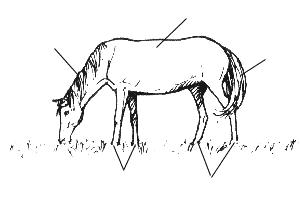Today I come to you with the third, final part of the trilogy of Master Classes for the whole family (The first two parts are here and here). It will be for our men. For our dear and beloved men! Even if they are sometimes harmful, and itchy, and naughty, and capricious, but still they are our beloved men, without whom we simply cannot live! Well, what would we do without them? Who will we then grumble at, itch, find fault with, be capricious in front of whom, and much, much more, which a woman cannot live without!? And we women have a lot of men! Husbands, sons, brothers, fathers, fathers-in-law, friends, neighbors, and other very different representatives of the stronger sex... And I want to please almost everyone pleasant little things. After all, just like us, they love gifts very much and enjoy them like children!
Today I want to show you how to sew a tool bag. I drive my car a lot, but I never pay attention to the various knocking and rattling noises that are sometimes heard in the cabin. My husband, on the contrary, just listens all the time - where something happened... So we are going, for example, to the dacha, I tell him something, I burst into a nightingale, I describe everything so colorfully, in the faces, with foam on the lips , and suddenly in the middle of my monologue he suddenly declares: “Something hit. Listen, where is it?” In the first moments, I can’t even figure out what’s going on. It is very difficult to switch from your thoughts to his. Then I start turning my head in all directions, catching sounds. Sometimes I even crawl my head under the seat. So I’m spinning in all directions until we reach our destination... And then what kind of monologue did I have on the way - I forgot what I was talking about...
So this is what I mean... All men carry tools with them in the car that can be useful on the road. They, as a rule, are in original boxes, convenient packaging, etc.... In short, in sets. But there are all sorts of screwdriver keys, not in sets, but in bulk, which you can’t throw away and you have to carry them in different boxes or old buckets and boxes. Well, maybe I’m exaggerating a bit, but still. And these instruments begin to strum on every bump, preventing us women from chatting about this and that, because they distract the attention of our counterpart.
So, my dears, today I will show you how to sew a bag for tools in which they will not rattle. I have already sewn 5-6 such bags, I don’t remember exactly, but they were all made of thin tarpaulin. Now I haven’t found a thin tarpaulin, so I’m showing you one on dermantine.
This is the kind of bandoleer for tools we will sew today. So let's get started.
For this we need:
- dermantin or other thick fabric(you can also use an old tapestry);
- trouser braid;
- Velcro tape;
- tailor's pins (my pins are at the dacha, so I used decorative ones);
- chalk;
- pencil;
- rulers;
- threads, scissors.

Girls, I can’t give you a pattern for such a thing, because everything here is strictly individual. Whatever tools a man gives you, that’s how you should size them.
So, take a piece of dermantine and bend the bottom to the size of it big tool. In this case, I have the key.
We lay out all the tools we need, deciding on the length of the bag and the number of cells in the pocket.

Use a tailor's pin to pin the cell to the required width.

We do the same with all other tools. Oh, where have our tools gone? Hush, girls, don't panic! The situation is under control!

Here they are, my dears! They simply fell headlong into these deep cells.

We take out all the tools and begin cutting and adjusting the bag to size. We draw a line with chalk along which we will cut off the excess. Don't forget the hem allowance!

Trimmed. 3-3.5 centimeters above the largest key, draw a line parallel to the top cut of the pocket.

This is what we got. Stepping back 2 cm from the top of the pocket, draw a line along which we will make a fold.

They turned it down. Stitched. I laid 2 parallel lines.

Now we remove the pins and draw seam lines using the marks with chalk.

Let's sew. To strengthen the seams, I stitched back and forth along one line. For ease of work and to prevent pins from pricking, I rolled the product into a roll.

So, we stitched. This is what we got. The pocket with cells is ready. Now we need to sew a valve that will cover our tools on top. We place the resulting part on a piece of newspaper, determine the height of the valve and cut off the excess around the perimeter.

We try on the part obtained from the newspaper to our pocket. This is what the bag flap will look like. We cut out the valve from dermantine.

We begin to process the bottom of the valve with braid. WITH wrong side We overlap the bottom of the flap with braid and stitch it. The overlap width is 5-6 mm.

We turn it over to the front side, fold the braid over it and stitch it. Having processed the bottom of the valve, we begin to process its sides. On the sides we sew a braid 6-7 mm longer than the bottom edge.

Girls, we leave these tips only on the sides of the parts and only at the bottom! Look at photo 19. The top and bottom of the product are clearly visible there.

We tape the sides of the bottom of the bag.

This is what the ends should look like. This is necessary in order to carefully process the bottom of the resulting seam. We will bend this tip to reverse side of our bag and attach it with a zig-zag stitch in one place. For those who don’t have such a stitch, you can simply attach it with a needle and thread.

This is how you get the corner of the valve.

So, we have two parts - the valve and the pocket itself.
We place the flap on the pocket, align the top edge and trim it with braid.

This is what we ended up with. The bag is ready. Almost...

We begin to arrange the tools into cells. Small keys are clearly drowning in their cells! Here's what we do...

We place all the small keys on the cells on the same level as the large ones. Under the small keys we draw a line with chalk, along which we will sew a double line - these are the future bottoms of the cells. We draw a line under the smallest keys on each cell, not reaching the side seams. Look, see? We will make cuts along these lines with a stationery knife. Insert a ruler into these two cells one by one and cut along these lines with a knife or scissors. Just be careful not to cut through the seams! And watch your fingers!

That's it. Stitched, cut through. They put the tools in their places. This is what we got. What? Are you asking why the last cell is empty? And this is a surprise for our man! I'll show you a little lower.

So, we sewed the bag.
Roll it up and measure it desired length Velcro tape, which was hooked at the very tip. Don't cut it short! It's better to have a reserve.

We sew the interlocked ends like this - double stitching around the perimeter.

We apply it to the bag at the attachment point.

Girls, we sew the ribbon not along the square, but along the yellow stripe that I drew! Make no mistake! So, the braid was sewn on with a triple stitch (back and forth).

And now our bag is completely ready! Oh, you're asking what's in the last pocket? Here's what...

Stash! Every man should have a stash, so we made it! Let him spend certain sums there, let him! We'll have everything under control, right? Just shhh, don’t tell anyone about this! And the man himself will be so glad that he has a place for his stash!

Well, this is what we sewed for you today! Not bad, right?
By the way, my husband spent the whole evening shifting back and forth different instruments, and therefore different variations of sets. Another good thing about this bag is that you can immediately see if any tool is missing after repair. You can’t roll it up half empty, right? And sometimes men forget different screwdrivers and keys where they were repairing. Then they shake us poor people like a pear - where did you put the key to twelve???

And here is the handbag assembled. There won't be anything rattling in the trunk now, so chat to your heart's content - no rattling in the trunk will stop your man from listening to you attentively!

Today I come to you with the third, final part of the trilogy of Master Classes for the whole family (The first two parts are here and here). It will be for our men. For our dear and beloved men! Even if they are sometimes harmful, and itchy, and naughty, and capricious, but still they are our beloved men, without whom we simply cannot live! Well, what would we do without them? Who will we then grumble at, itch, find fault with, be capricious in front of whom, and much, much more, which a woman cannot live without!? And we women have a lot of men! Husbands, sons, brothers, fathers, fathers-in-law, friends, neighbors, and other very different representatives of the stronger sex... And I want to please almost everyone with pleasant little things. After all, just like us, they love gifts very much and enjoy them like children!
Today I want to show you how to sew a tool bag. I drive my car a lot, but I never pay attention to the various knocking and rattling noises that are sometimes heard in the cabin. My husband, on the contrary, just listens all the time - where something happened... So we are going, for example, to the dacha, I tell him something, I burst into a nightingale, I describe everything so colorfully, in the faces, with foam on the lips , and suddenly in the middle of my monologue he suddenly declares: “Something hit. Listen, where is it?” In the first moments, I can’t even figure out what’s going on. It is very difficult to switch from your thoughts to his. Then I start turning my head in all directions, catching sounds. Sometimes I even crawl my head under the seat. So I’m spinning in all directions until we reach our destination... And then what kind of monologue did I have on the way - I forgot what I was talking about...
So this is what I mean... All men carry tools with them in the car that can be useful on the road. They, as a rule, are in original boxes, convenient packaging, etc.... In short, in sets. But there are all sorts of screwdriver keys, not in sets, but in bulk, which you can’t throw away and you have to carry them in different boxes or old buckets and boxes. Well, maybe I’m exaggerating a bit, but still. And these instruments begin to strum on every bump, preventing us women from chatting about this and that, because they distract the attention of our counterpart.
So, my dears, today I will show you how to sew a bag for tools in which they will not rattle. I have already sewn 5-6 such bags, I don’t remember exactly, but they were all made of thin tarpaulin. Now I haven’t found a thin tarpaulin, so I’m showing you one on dermantine.
This is the kind of bandoleer for tools we will sew today. So let's get started.
For this we need:
- dermantine or other dense fabric (you can also use an old tapestry);
- trouser braid;
- Velcro tape;
- tailor's pins (my pins are at the dacha, so I used decorative ones);
- chalk;
- pencil;
- rulers;
- threads, scissors.

Girls, I can’t give you a pattern for such a thing, because everything here is strictly individual. Whatever tools a man gives you, that’s how you should size them.
So, take a piece of dermantine and bend the bottom to the size of the largest tool. In this case, I have the key.
We lay out all the tools we need, deciding on the length of the bag and the number of cells in the pocket.

Use a tailor's pin to pin the cell to the required width.

We do the same with all other tools. Oh, where have our tools gone? Hush, girls, don't panic! The situation is under control!

Here they are, my dears! They simply fell headlong into these deep cells.

We take out all the tools and begin cutting and adjusting the bag to size. We draw a line with chalk along which we will cut off the excess. Don't forget the hem allowance!

Trimmed. 3-3.5 centimeters above the largest key, draw a line parallel to the top cut of the pocket.

This is what we got. Stepping back 2 cm from the top of the pocket, draw a line along which we will make a fold.

They turned it down. Stitched. I laid 2 parallel lines.

Now we remove the pins and draw seam lines using the marks with chalk.

Let's sew. To strengthen the seams, I stitched back and forth along one line. For ease of work and to prevent pins from pricking, I rolled the product into a roll.

So, we stitched. This is what we got. The pocket with cells is ready. Now we need to sew a valve that will cover our tools on top. We place the resulting part on a piece of newspaper, determine the height of the valve and cut off the excess around the perimeter.

We try on the part obtained from the newspaper to our pocket. This is what the bag flap will look like. We cut out the valve from dermantine.

We begin to process the bottom of the valve with braid. From the wrong side to the bottom of the flap, we overlap the braid and stitch it. The overlap width is 5-6 mm.

We turn it over to the front side, fold the braid over it and stitch it. Having processed the bottom of the valve, we begin to process its sides. On the sides we sew a braid 6-7 mm longer than the bottom edge.

Girls, we leave these tips only on the sides of the parts and only at the bottom! Look at photo 19. The top and bottom of the product are clearly visible there.

We tape the sides of the bottom of the bag.

This is what the ends should look like. This is necessary in order to carefully process the bottom of the resulting seam. We will fold this tip onto the back of our bag and attach it with a zig-zag stitch in one place. For those who don’t have such a stitch, you can simply attach it with a needle and thread.

This is how you get the corner of the valve.

So, we have two parts - the valve and the pocket itself.
We place the flap on the pocket, align the top edge and trim it with braid.

This is what we ended up with. The bag is ready. Almost...

We begin to arrange the tools into cells. Small keys are clearly drowning in their cells! Here's what we do...

We place all the small keys on the cells on the same level as the large ones. Under the small keys we draw a line with chalk, along which we will sew a double line - these are the future bottoms of the cells. We draw a line under the smallest keys on each cell, not reaching the side seams. Look, see? We will make cuts along these lines with a stationery knife. Insert a ruler into these two cells one by one and cut along these lines with a knife or scissors. Just be careful not to cut through the seams! And watch your fingers!

That's it. Stitched, cut through. They put the tools in their places. This is what we got. What? Are you asking why the last cell is empty? And this is a surprise for our man! I'll show you a little lower.

So, we sewed the bag.
We roll it up into a roll and measure the required length of the Velcro tape, which is hooked at the very tip. Don't cut it short! It's better to have a reserve.

We sew the interlocked ends like this - double stitching around the perimeter.

We apply it to the bag at the attachment point.

Girls, we sew the ribbon not along the square, but along the yellow stripe that I drew! Make no mistake! So, the braid was sewn on with a triple stitch (back and forth).

And now our bag is completely ready! Oh, you're asking what's in the last pocket? Here's what...

Stash! Every man should have a stash, so we made it! Let him spend certain sums there, let him! We'll have everything under control, right? Just shhh, don’t tell anyone about this! And the man himself will be so glad that he has a place for his stash!

Well, this is what we sewed for you today! Not bad, right?
By the way, my husband spent the whole evening moving different instruments back and forth, hence the different variations of the sets. Another good thing about this bag is that you can immediately see if any tool is missing after repair. You can’t roll it up half empty, right? And sometimes men forget different screwdrivers and keys where they were repairing. Then they shake us poor people like a pear - where did you put the key to twelve???

And here is the handbag assembled. There won't be anything rattling in the trunk now, so chat to your heart's content - no rattling in the trunk will stop your man from listening to you attentively!

I don't work to order all the time, but from time to time I agree to interesting offers. So I agreed to something I haven’t sewed yet - a cover for manicure tools, one handicraft mother ordered this as a gift for her daughter to give her a cover self made, filled with all sorts of necessary manicure things, for March 8, it’s so cute!
The case is sewn like a knitting needle organizer, only the size is small, 21.5*21.5 cm. Fabrics: American cotton, non-woven and felt padding. The cells are covered by a wide flap, which is modestly decorated with lace.  There are five cells in total, two are for scissors, one for a nail file, and two more for narrow things) Considering the purpose of the cells, I put a strong lining in them with a dense weave of threads and additionally sealed the cells for scissors with hard dubbing. Considering the height of the scissors/files and the proportions of the organizer, the lining in the cells for the scissors is shortened, but this is not visible from the outside, everything is hidden inside.
There are five cells in total, two are for scissors, one for a nail file, and two more for narrow things) Considering the purpose of the cells, I put a strong lining in them with a dense weave of threads and additionally sealed the cells for scissors with hard dubbing. Considering the height of the scissors/files and the proportions of the organizer, the lining in the cells for the scissors is shortened, but this is not visible from the outside, everything is hidden inside.  The filled cover can be folded in half or three times and tied with a cotton cord and a button. The ties are sewn on top of the finished cover, so if necessary, they can be altered to a more convenient place.
The filled cover can be folded in half or three times and tied with a cotton cord and a button. The ties are sewn on top of the finished cover, so if necessary, they can be altered to a more convenient place.  I hope that the case, along with its contents, will please its owner and will serve her well for a long time :)
I hope that the case, along with its contents, will please its owner and will serve her well for a long time :)
Thank you for visiting! Have a sunny, peaceful day and good news everyone!
DIY travel travel case for manicure tools
I suggest you make a travel travel case for manicure tools yourself, with your own hands. To work you will need cardboard, fabric, rubber bands and glue. Let's look at the photo master class? Maybe some of you will smile), you can buy a toiletry case... But you can buy absolutely everything, if only you had the money) It’s much more interesting to create something you need with your own hands. It's such a pleasure to admire your creations)
So, for work we need cardboard, from which we cut out rectangles:
4 rectangles measuring 4 by 11 cm and 1 - 10 by 11 cm.
We glue the cardboard parts together using sheets of paper or tape. See the gluing sequence below:

Lubricate the glued workpiece generously with PVA glue and leave for 10 minutes. 
Glue the fabric as shown in the photo below

For this we need an elastic band, only 20 cm. If you don’t have such a device, you can simply cut the cardboard and glue the elastic bands

We prepare from cardboard and fabric inner side travel bag
It will crumble. In addition, the fickle female fantasy requires the manicurist, hairdresser, makeup artist, lash maker or cosmetologist to bring with them enough a large number of necessary products and accessories. This means that on the spot, in order to save the client’s precious time, you need to clearly know what is in your purse or toiletry case. That is why many well-known brands in the beauty industry have supplemented their accessories with a variety of cases, bags and travel bags. Let's look at the types and purposes of various beauty cases and important parameters that you need to pay attention to when buying the suitcase you need.
Case for a manicurist: why is it needed?
A master who makes his clients beautiful must be a professional in everything. Appreciate comfort and convenience both in your work and when surrounding girls who want to have a stylish manicure, beautiful skin or a spectacular hairstyle. That is why many specialists on duty, working with a large number of auxiliary drugs and accessories, acquire convenient organizers. Due to the characteristics of a particular profession, either a bag for a makeup artist or a stylist, as a rule, differs from a suitcase for a manicurist. Moreover, as soon as the master has his own regular customers, which he values very much, professionals often acquire separate ones for each specific customer. And, of course, it is more convenient to store and transport them in a separate bag. Another significant advantage of this approach to organization and storage is the convenience of conducting an audit before purchasing items that have ended or are ending. Supplies.


However, the benefits of owning a professional beauty case are not limited to this. When purchasing the necessary suitcase organizer for themselves, experts in the beauty industry put forward the following arguments in favor of a stylish assistant:
- high-quality, practical and convenient emphasizes the status of the master as a professional.

- a bag or case where everything is in its place and always available will illustrate you as a person who values organization and order.

- A travel bag-suitcase is, first of all, convenient and practical.

As the experience of long-time practicing craftsmen shows, storing all your wealth in suitcases is more efficient and expedient also because dust and dirt do not accumulate inside when closed. And once you have laid out everything you need in an order that is convenient for you, you can rest assured that upon arrival at your client’s home or office, small decor will be just as neat and aesthetically pleasing as in your home or office.
How to choose the right model
To begin with, decide on the shape of the bag that is convenient for you. It can be: , . Depending on how you plan to get to your client, you should choose beauty bags that suit the weather conditions. Some of your materials may not tolerate cold well, while others may not tolerate elevated temperatures. Typically, materials such as:, , are used for beauty cases. Or combined for a more presentable appearance.
How to choose the right suitcase for a nail artist?
As a rule, manicurists select a case for their model (or). Therefore, the suitcase must have at least 5 compartments: for equipment and small ones for various decorative materials, coverings ( , ) and .


Based on volume, suitcases for the master are:
- . Usually made of metal (expensive models) or plastic (economy segment), combined cases made of aluminum with leatherette inserts are also often found. All models have soft fabric interior upholstery and are often equipped with,.
aluminum: characterized by long term service, the ability to maintain aesthetic appearance for a long time appearance. Many manufacturers create cases with a streamlined shape, with rounded corners, to eliminate the risk of accidental injury. One of the disadvantages of such assistants is that they are quite heavy;
fabric: will not cause you any inconvenience when traveling, for example, on public transport. They are compact and lightweight, with optimal capacity. Their main disadvantage is the need to equip them with additional plastic organizers due to the lack required quantity trays and compartments;
leather (imitation reptile skin): combine the advantages of metal and fabric models. They are often chosen if they prefer their work bag to look as feminine and stylish as a regular ladies bag. A nice bonus of such cases is that inside they are arranged as conveniently as expensive professional suitcases.

Based on the materials used, the most practical models are:



The right model, taking into account all your wishes and needs, will allow you to work comfortably and calmly, without fear for the safety of the tools and equipment used in your work. A modern, ergonomic, practical and stylish suitcase will make as good an impression on your clients as your skills and professionalism. Do not deny yourself this reliable and faithful assistant, remembering the importance of the first impression you make on the client. No one has yet canceled the rule “Meet by clothes, escorted by nails.” The case looks noble and rich, emphasizing your image of a high-level professional.








